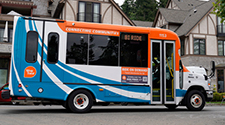LEARN KITSAP TRANSIT
CTR Law
About the CTR Law
Washington State’s Commute Trip Reduction (CTR) Law was passed by the Legislature in 1991 with goals to improve air quality, reduce traffic congestion, and reduce the consumption of petroleum fuels through employer-based programs that encourage the use of alternatives to driving alone. Alternatives include riding the bus or train, carpooling, vanpooling, bicycling, walking, working a compressed work week or teleworking.
The Washington State Legislature passed the CTR Efficiency Act in 2006 and revised the goals for trip reduction; each city and county must reduce drive alone trips at major worksites by 10% by 2011. Local jurisdictions have revised their CTR ordinances and published new CTR goals for employers.
The law requires major employers to develop and implement an employee commute program to reduce the number and length of drive-alone commute trips made to the worksite. Local jurisdictions (cities and counties) implemented ordinances to define how the law would apply to worksites in their area. Local jurisdictions are required to provide training and technical assistance for employers.
The CTR program benefits our state’s transportation system, economy, CTR participants and other drivers on the road. Between 2007 and 2016:
- Employees at 955 CTR-affected worksites increased their non-drive-alone trip rate from 34.3% to 39.1%, representing a 4.8% increase from the original rate. They left about 22,400 cars home at work every day, and commuted by other means such as bus, vanpool, train, walking, biking or teleworking, resulting in less traffic congestion.
- The average vehicle miles traveled per surveyed employee declined by 7.4%. The overall miles decreased by about 79 million miles annually. This results in a reduction of 3.7 million gallons of fuel, saving commuters almost $10 million in fuel expenditures. This translates into an annual greenhouse gas emission reduction of 33,500 metric tons, the equivalent of 180 rail cars of coal or the same amount of carbon sequestered annually by about 31,500 acres of forest: enough trees to cover almost 60% of Seattle.
Source: 2017 CTR Report To the Washington State Legislature.
To read more about the costs and benefits of the CTR Program, download the 2017 CTR Report to the Washington State Legislature.

 Routed Buses
Routed Buses On-Demand/Dial-A-Ride
On-Demand/Dial-A-Ride Worker/Driver
Worker/Driver Ferries
Ferries ACCESS & VanLink
ACCESS & VanLink Vanpool, Carpool, SCOOT
Vanpool, Carpool, SCOOT









